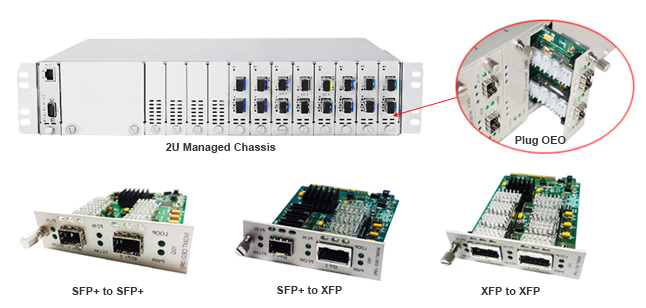What's the Difference Between Fiber Transceiver & Transponder?
First, in order to better understand the difference between a fiber optic transceiver and a fiber optic transponder, we need to define what each one does.
Fiber Optic Transceiver Most systems use a "transceiver" which includes both transmission and receiver in a single module. Its purpose, in broad terms, is to transmit and receive data. In fiber optic communication, the commonly used transceiver modules are hot-swappable I/O (input/output) devices which plug into module sockets. The transceiver acts to connect the electrical circuitry of the module with the optical or copper network. Devices such as routers or network interface cards provide one or more transceiver module slot (e.g GBIC, SFP, XFP), into which you can insert a transceiver module which is appropriate for that connection. The optical fiber, or wire, plugs into a connector on the transceiver module. There are multiple types of transceiver module available for use with different types of wire, fiber, different wavelengths within a fiber, and for communication over different distances. The most commonly used fiber optic transceivers include GBIC, SFP, SFP+, XFP, CFP, QSFP etc. They are widely used for different application, eg. 10G, 40G fiber optic transmission.
Fiber Optic Transponder "Transponder" includes a transmitter and a responder. It is a similar device with transceiver. In optical fiber communications, a transponder is the element that sends and receives the optical signal from a fiber. A transponder is typically characterized by its data rate and the maximum distance the signal can travel. According to its specific applications, it is also known as wavelength-converting transponder, WDM transponder or fiber to fiber media converter. Fiber optic Transponders extend network distance by converting wavelengths (1310 to 1550), amplifying optical power and can support the “Three Rs” to Retime, Regenerate and Reshape the optical signal. In general, there is an O-E-O (optical-electrical-optical) function with this device. Fiber optic transponders and optical multiplexers are usually present in the terminal multiplexer as an important component for WDM (Wavelength Division Multiplexing) system. In addition, in nowadays market, many transponders are designed as protocol and rate-transparent fiber media converters that support SFP, SFP+ and XFP transceivers with data rates up to 11.32 Gpbs, and with seamless integration of different fiber types by converting multi-mode fiber to single-mode fiber, and dual fiber to single-fiber.

Fiber Optic Transceiver vs Fiber Optic Transponder A transponder and transceiver are both functionally similar devices that convert a full-duplex electrical signal in a full-duplex optical signal. The difference between the two is that fiber transceivers interface electrically with the host system using a serial interface, whereas transponders use a parallel interface. So transponders are easier to handle lower-rate parallel signals, but are bulkier and consume more power than transceivers. In addition, transceivers are limited to providing an electrical-optical function only (not differentiating between serial or parallel electrical interfaces), whereas transponders convert an optical signal at one wavelength to an optical signal at another wavelength. As such, transponders can be considered as two transceivers placed back-to-back.
Author's Note I hope you can start down the path to fully understanding transceivers, transponders, and the difference between them, particularly in a networking, Ethernet, or fiber-optic communications setting after reading this article. Of cause, knowledge is endless, if you still want to get more information about transceiver and transponder, I suggest that you should find more references to read. If you just need to buy the related products, I will recommend Fiberstore.com to you as usual. Fiberstore supplies 100% compatible fiber optic transceiver for many brands, such as Cisco SFP, Dell SFP/SFP+ and Netgear SFP Transceivers, etc.
Article Source: Difference Between Transceiver & Transponder
